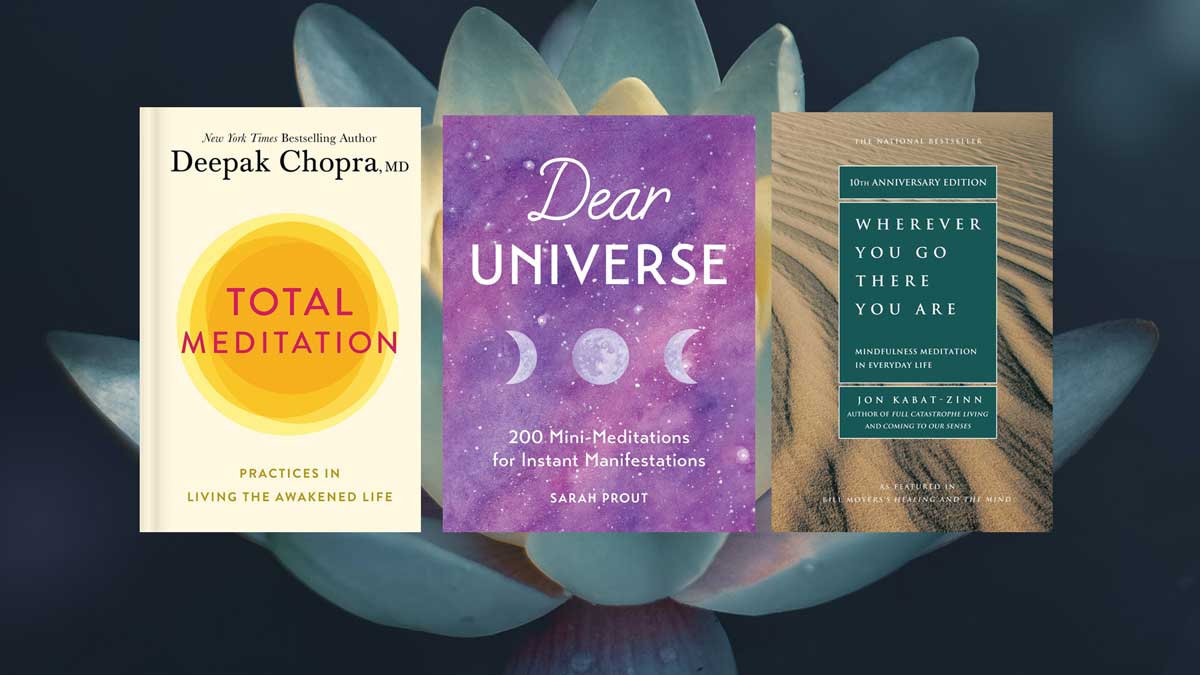
Above: Photo Collage / Publishers
Meditation is a proven way to improve mental and physical wellbeing: digital interruptions notwithstanding…
Very few activities, free no less, have the power to improve our lives as much a a regular meditation schedule, adhered to with fidelity and regularity. And yet, with digital interruptions and background static rising and increasing in intensity, it seems nearly impossible to find the time.
For me this transpires something like this: At 8am I set my timer for 15 minutes of peaceful, transcendental meditation that will, hopefully, start my day off right. Inevitably, within a minute or two there’s a text, then a “scam likely” phone call, then the leaf-blower from the street erupts in a cacophony of nearly atomic proportions (ok that’s not digital), and I either abort or have to keep restarting the timer.
There is a new apple iOS 15 feature (currently in beta but coming to the general public in September) called “Focus” that can temporarily mute all interruptions for a set time or activity. Kudos to Apple for providing a blinding obvious feature that allows you to mute or at least minimize the domination of your life by their product.
In the end, even when faced with what seems, at times, like an endless struggle to carve out the time and, yes, focus, to concentrate on something that is without the slightest doubt a boon to my existence, the end goal is clearly worth it.
When I manage to mute and muzzle all the interrupting and constant message and warnings and notifications and actually stick to the plan (15 minutes 2 times daily in my case) the positive results are obvious.
My day is less disaster more bliss and, when I achieve this modest minimum time investment on multiple consecutive days, there’s a feeling that my life is actually improving, rather than being held hostage by a digital daemon.
You, too, can reduce stress and potentially heal your body and mind in this way, with two simple steps.
First learn to meditate, either from a book, for example in the selection below, or from a teacher (my Transcendental Meditation teacher provided me with a mantra like in the Woody Allen film) and then find a way to cut through the digital chaos of modern life to practice on your own and reap the rewards.
Wherever You Go, There You Are: Mindfulness Meditation in Everyday Life
Originally published back in 1994, even after 20+ years has continued to top bestseller lists.
This books is both simple and a straightforward introduction to Buddhist meditation practices. Dr. Kabat-Zinn lays out within the text mindful meditation techniques any one can use in everyday living.
For more on this time-honored book, check out “Wherever You Go“
Dear Universe: 200 Mini-Meditations for Instant Manifestations
Dear Universe invites you to harness the power inside you to achieve anything your heart desires. Author Sarah Prout shows readers how to best utilize your feelings in order to create success, love, joy, and all the abundance you deserve.
There are 200 mini meditations, 100 to rise above and conquer fear and another 100 to embrace love.
To look into this book of empowerment, check out “Dear Universe“.
Total Meditation: Practices in Living the Awakened Life
Deepak Chopra is synonymous with many as the holistic health guru, and Chopra has been at the forefront of meditation in the West for over 30 years.
Total Meditation offers an exploration of the physical, emotional, relational and spiritual. He teaches readers how to wake up and gain new levels of awareness to cultivate clarity.
Learn more on “Total Meditation“.
8 Minute Meditation Expanded: Quiet Your Mind. Change Your Life.
This 10th anniversary edition, gives beginner to the art of meditation the exact tools needed learn to effectively meditate. Even for the busiest of people, the time-frame of 8 minutes is relatively easy to handle.
Inside readers get step-by-step instructions, frequently asked questions on meditation, and even “trouble shooting” if you get struck.
Get a jumpstart on meditation by checking on “8 Minute Meditation“
Related Articles:
- Stress is Part of Life: Burnout doesn’t have to be
- Primal Movement for fitness in 2023
- Counting Calories to Slim Down? Here’s a Guide to Doing it Right
- Learning to Fly: Hurry up and Learn Meditation or be left Ungrounded: Books
- Feeling the Stress? Yoga Techniques have been giving Relief For Thousands of Years
Find books on Music, Movies & Entertainment and many other topics at our sister site: Cherrybooks on Bookshop.org
Enjoy Lynxotic at Apple News on your iPhone, iPad or Mac.
Lynxotic may receive a small commission based on any purchases made by following links from this page
